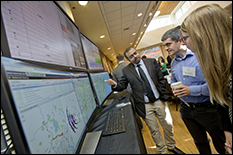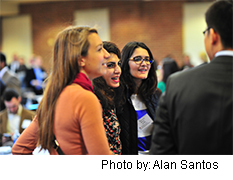U.S. Secretary of Transportation Anthony Foxx Headlines University of Maryland Transportation Summit
Nearly 200 transportation experts from government, industry, and academe joined forces for the University of Maryland (UMD) National Transportation Center’s (NTC@Maryland) Transportation Innovation and Policy Summit, held on April 14 at the university campus in College Park, in support of the theme, “Innovation Multimodal Solutions for Reducing Congestion.” U.S. Secretary of Transportation Anthony Foxx, Maryland Secretary of Transportation Pete Rahn, Maryland State Highway Administrator Gregory Johnson, and FHWA Office of Transportation Management Director Robert Arnold were among the featured keynote speakers. They were joined by NTC@Maryland and peer university transportation center representatives, as well as experts from the UMD Center for Advanced Transportation Technology and National Center for Smart Growth. Each of the day’s speakers emphasized technology and policy innovations for reducing congestion, and the impact of transportation on both local and national economies.
“From the advent of aviation to the transcontinental railroad, we’ve been on a steady march throughout most of our nation’s history to create methods and mechanisms by which we can move to places faster,” Secretary Foxx said. “That’s a huge accomplishment for any civilization. A big part of [improving transportation] is how we integrate those systems. How do we make them like the fingers of a hand that can create a fist to punch better or higher or more impactful than the individual parts?” Foxx stressed the need to overcome the challenges that stovepipe federal regulations present as the country works to meet 21st-century demands for transportation innovation. “In order for us to break through and achieve greater results for our overall system, we’re going to have to rely on the state and local governments to think in an integrated fashion about their assets,” he said, touching on the critical importance of the Department of Transportation’s (DOT) Beyond Traffic framework. The document, which maps U.S. DOT’s 30-year framework for U.S. transportation, underscores critical decision points driven by data analysis, research, and expert opinions. “The challenges [we face] are significant. One is, population growth,” Foxx said, noting that over the next 30 years, 70 million more people will compete for use of the same space on which U.S. commuters and freight transportation travel today. “We need to understand that the challenges of congestion are going to be worse.” One of the areas from which transportation planners must pull data is driver behavior, Administrator Johnson noted. “Driver behavior is the key to how we design our facilities,” he said. “We think we know how drivers will react to certain amenities, certain signs, certain things we put on our roadways. By having better data, can we base certain aspects of what we do [such as road signs] on how our drivers perceive those types of things in real time? Having those types of data points will make us more efficient and will make sure we are spending dollars in the right way.” Knowing well the benefits of collecting big data to evaluate transportation systems, UMD’s Center for Advanced Transportation Technology Laboratory (CATT Lab) collects billions of data points each day on transportation systems across 26 U.S. states.
“The goal of this system was originally to go out and work with D.C., Maryland, and Virginia to grab all of the relevant transportation data—anything you can possibly think of that might affect a transportation system, such as congestion and incident management—bring it together, from each of those different states, and then be able to standardize it, fuse it, and share it with each other so that if an incident was going on in Maryland, D.C. and Virginia would know about it—they could know about it—and vice versa,” Pack said. Today, 26 states across the country use RITIS, for which the CATT Lab manages data points on everything from basic traffic speed and volume and bus and train schedules to censor measurements and GPS data. From probes alone, CATT Lab collects almost 6.5 billion records every single day—and they estimate that number will jump to 8 trillion records per day in as little as a year and a half. “Our goal now is to take all of this data that we’ve been pulling in for years and years and make it easily accessible and understandable to any and every end user,” Pack said. “That could mean us—the researchers—it could be transportation operations folks, it could be engineers, it could even be the media and the public.” But, the CATT Lab’s end goal extends beyond reporting this information to constituents. They also hope to use this information to analyze—and even predict—how factors will impact a transportation system in real-time. One key area in which predictive capabilities would prove valuable is incident management. “We’re getting lots and lots of information that tells us when an incident occurs, where an incident occurs, which responders are on the scene; we know which lanes are closed and when, what types of signs are being posted,” Pack said. “Well, now we’re working on solutions that allow the operator to—in real time—get automated information pushed to them that says, ‘Based on the incident that is going on right now, we expect that incident to last “X” number of minutes or “X” number of hours. And, by the way, if you do “X,” you can then influence the duration that incident in one direction or another in terms of costs, severity, and so forth.’” Further emphasizing how critical it is to plan and adapt for the future of transportation, Administrator Johnson echoed Secretary Foxx’s concerns about funding constraints that limit the ability to make the vision of 21st century transportation a reality.
“We have to also think about the lifelines that support our transportation systems, and the factors that interrupt our transportation systems,” noted Elise Miller-Hooks, a professor with UMD’s Department of Civil and Environmental Engineering, and director of the Civil Infrastructure Systems (CIS) and Critical Resilience Interdependent Infrastructure Systems and Processes (CRISP) programs with the National Science Foundation. “We need to be thinking about these dynamical systems, controlling these systems when they’re decentralized, and the types of information we’re collecting from various sources.” And, the focus of transportation development cannot be separated from that of economic development, Secretary Foxx noted.
“The concept of transportation isn't just ‘place getting,’” he said. “It's ‘place making.’”
All featured photos were provided courtesy of John T. Consoli/University of Maryland unless otherwise noted. Alan P. Santos provided additional photography support as well.
Related Articles: April 22, 2016 Prev Next |



 “Traffic congestion is an old problem, for which we see promising new solutions based on big data analytics, connected vehicles and automation, sharing economy, and behavior research breakthroughs,” said Lei Zhang, Director of NTC@Maryland and UMD Department of Civil and Environmental Engineering Herbert Rabin Distinguished Professor. “The successful development and implementation of many of these innovative congestion mitigation solutions require partnerships among federal, state, local governments, the private sector, and universities. Such partnerships ensure that we are collectively working toward a future that supports economic growth and opportunity equity. It is wonderful that so many decision-makers came together for our summit to discuss these issues and share their perspectives.”
“Traffic congestion is an old problem, for which we see promising new solutions based on big data analytics, connected vehicles and automation, sharing economy, and behavior research breakthroughs,” said Lei Zhang, Director of NTC@Maryland and UMD Department of Civil and Environmental Engineering Herbert Rabin Distinguished Professor. “The successful development and implementation of many of these innovative congestion mitigation solutions require partnerships among federal, state, local governments, the private sector, and universities. Such partnerships ensure that we are collectively working toward a future that supports economic growth and opportunity equity. It is wonderful that so many decision-makers came together for our summit to discuss these issues and share their perspectives.” CATT Lab director Michael Pack offered an inside look at what the team calls RITIS—the Regional Integrated Transportation Information System, an automated data-sharing, dissemination, and archiving system that includes many performance measure, dashboard, and visual analytics tools to help agencies gain situational awareness, measure performance, and communicate information between agencies and to the public.
CATT Lab director Michael Pack offered an inside look at what the team calls RITIS—the Regional Integrated Transportation Information System, an automated data-sharing, dissemination, and archiving system that includes many performance measure, dashboard, and visual analytics tools to help agencies gain situational awareness, measure performance, and communicate information between agencies and to the public. “We are looking to fund a 21st century transportation system with a 20th century funding mechanism,” he said. “We’re stuck in the past of fuel taxes, which are diminishing. We need to look at more collaborative ways. There are things we need to come to grips with as a state, as a country, that we need to look for that next, more efficient way of how to fund not only transportation, but the things that sit underneath our transportation. We look at our transportation infrastructure and we know that we are keeping things moving forward, but there are other parts of our infrastructure—our water infrastructure, for instanc—that are crumbling.”
“We are looking to fund a 21st century transportation system with a 20th century funding mechanism,” he said. “We’re stuck in the past of fuel taxes, which are diminishing. We need to look at more collaborative ways. There are things we need to come to grips with as a state, as a country, that we need to look for that next, more efficient way of how to fund not only transportation, but the things that sit underneath our transportation. We look at our transportation infrastructure and we know that we are keeping things moving forward, but there are other parts of our infrastructure—our water infrastructure, for instanc—that are crumbling.” “The second largest expense for most low income families is transportation,” he said. “We have too many zip codes in this country where, if you’re born into the area, it’s too hard to get out of it. And, as transportation stakeholders, we need to do everything we can to ensure mobility for everyone.”
“The second largest expense for most low income families is transportation,” he said. “We have too many zip codes in this country where, if you’re born into the area, it’s too hard to get out of it. And, as transportation stakeholders, we need to do everything we can to ensure mobility for everyone.”